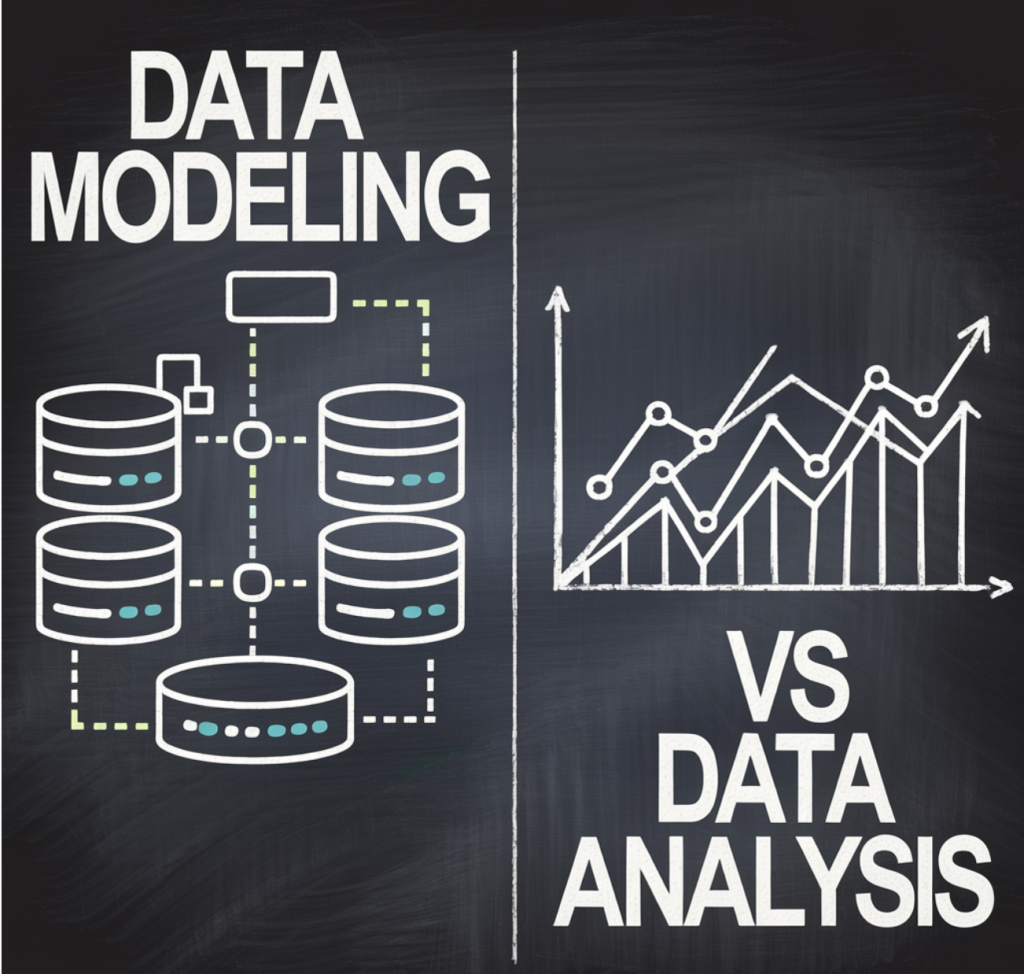

Data modeling and data analysis are two fundamental ideas in the contemporary field of data science that frequently overlap but are very different from one another. Although both are crucial in turning unstructured data into insightful knowledge, they are essentially distinct procedures with distinct functions in a data-driven setting. Anyone who works with data, whether they are an IT specialist, business analyst, or data scientist, must be aware of their distinctions. Data modeling and data analysis have been thoroughly compared in this article, which also explains their definitions, main distinctions, types, procedures, and advantages.
Data modeling
The process of planning and developing a blueprint for the organization, storage, and accessibility of data in a database or information system is known as data modeling. It includes specifying the relationships, organization, and interactions between various data items. Data modeling aims to ensure that the system’s database appropriately reflects the organization’s data requirements while preserving consistency and integrity.
Making diagrams and schemas that show the relationships between elements in a system is the foundation of data modeling. Customers, goods, sales transactions, and inventory are a few examples of the entities that can be involved in these partnerships. An Entity-Relationship Diagram (ERD), which graphically illustrates the connections between various entities, is a popular method in data modeling. Before any data analysis can be done on the structured data, data modeling is a crucial stage that is frequently employed in database design and management.
Hierarchical models, relational models, object-oriented models, and dimensional models are among the several forms of data modeling. Depending on the organization’s requirements and the complexity of the data, each category has distinct use cases. For instance, dimensional models are employed in data warehousing for business intelligence purposes, but relational models are frequently utilized in transactional databases.
Data Analysis
Data analysis is the process of looking at, cleaning, converting, and modeling data to get valuable insights. Data analysis is the process of analyzing data to find patterns, trends, and relationships, as opposed to data modeling, which is focused on how data is organized and stored. The main goal of data analysis is to provide actionable insights from raw data so that organizations may make well-informed decisions.
Data collection, data cleansing, exploratory data analysis (EDA), statistical analysis, and interpretation are the usual steps in the data analysis process. Analysts process data, find correlations, provide reports that support decision-making, and employ a variety of tools, methods, and algorithms. Depending on the analysis’s objectives, data analysis can be descriptive, diagnostic, predictive, or prescriptive.
- Using visual aids like charts and graphs, descriptive analysis summarises a dataset’s key characteristics.
- Diagnostic analysis aims to identify patterns in the data or the reasons for previous occurrences.
- The predictive analysis forecasts future trends or behaviors based on historical data.
- Prescriptive analysis helps firms take proactive measures by offering suggestions based on data insights.
Important Distinctions Between Data Analysis and Data Modelling
Although they both work with data, data modeling, and data analysis have different goals and methods. The goal of data modeling is to design the structure of data, making sure that it is consistent, well-structured, and easily accessible. It specifies how information will be kept and connected to other information within a system. Contrarily, data analysis focuses on analyzing data to produce insights and direct decision-making.
Process: Creating entity-relationship diagrams and schemas and describing the connections between various data items are all part of data modeling. The groundwork for data storage and retrieval is laid at this preparatory stage. To find patterns and create predictions, data analysis, on the other hand, includes dealing with real data, cleaning it, and using statistical and machine learning techniques.
Database architecture and data structures are the main topics of data modeling. It establishes the structure and storage of data, making it simpler to query and retrieve when required. On the other hand, data analysis focuses on using data to address particular issues or provide answers to certain business challenges. It is more important to comprehend the significance of the data than to store it.
Tools and Techniques: Database management systems (DBMS) such as SQL or NoSQL databases, ERDs, and UML diagrams are all essential components of data modeling. In contrast, data analysis uses specialized software for statistical analysis and machine learning, as well as programs like Excel, R, and Python.
Complementary Functions in a Data-Driven Organisation
Although data modeling and data analysis have different functions, they are both essential to a data-driven organization and work well together. An organized and structured approach to data storage is offered by a well-designed data model, which facilitates analysts’ access to and manipulation of the data. Ineffective, haphazard, and error-prone data analysis might result from improper data modeling. On the other hand, data analysis offers insights that direct advancements in data modeling, guaranteeing that the data structure adapts to the business’s shifting requirements.
For example, during exploratory data analysis (EDA), a data model may need to be modified to account for new data associations found during the analysis. A data model that facilitates the storing and retrieval of time-series data or big datasets may also be necessary for predictive analytics.
Conclusion
In conclusion, both data modeling and data analysis are essential components of the data science workflow; their roles are distinct but complementary. While data analysis is on analyzing the data to produce insights and help in decision-making, data modeling is concerned with creating the relationships and structure of data within a system. Organizations can more effectively use data to propel commercial achievement by comprehending the distinctions and connections between these two ideas.
The post Data Modeling vs Data Analysis: An In-Depth Comparison appeared first on MarkTechPost.
